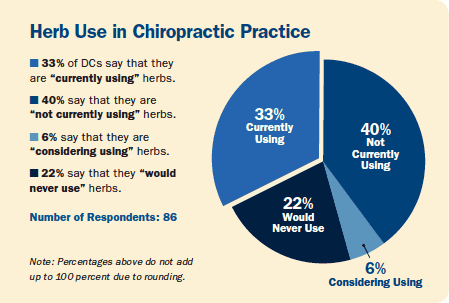 |
|
| ||||||||
|
|
|
February, 2010 Your FindingsBy DCPI Staff Our recent Dynamic Chiropractic poll asked: "Are you using herbs in your practice?" Fully one-third of our respondents said they are currently using herbs, while just 22 percent said they would never consider them for their patients. Meanwhile, national studies conducted in recent years show that the use of herbal supplements is widespread and growing in the U.S. A 2007 article written by Sherri Fechter, an Oregon Health and Science University dietetic intern, examines a 2002 health and diet survey that found: "73 percent of the adults surveyed used any kind of supplement, with 42 percent of all users reporting use of any kind of herb, botanical or other various dietary supplements (excluding vitamins and minerals)."1 According to Fechter, "This survey also discovered that older age groups had higher herbal use, as well as higher use among women. The most commonly reported herbs used included echinacea, garlic, gingko, ginseng and glucosamine. With the increasing availability and popularity of herbal supplements, it is becoming evident that the aging population is also starting to use alternative therapies like herbs. A survey of older adults not residing in nursing homes found that 19 percent of adults over the age of 52 surveyed reported using herbal supplements, with women and Caucasians being more likely to use herbs when compared to their counterparts." Fechter's article also notes a study done at a southeastern university, which found: "79 percent of students surveyed reported having used at least one herbal substance in the past 12 months. The most frequently used substances were green tea, ginseng, chamomile, ginger, and echinacea." As these numbers continue to increase and as people of all ages continue to using herbal supplements, it is important for health care practitioners, including chiropractors, to have a basic knowledge of commonly used herbs.

While 6 percent of those who responded to our poll are just considering using herbs and 22 percent say they would never use herbs, the use of herbal supplements by the public continues to rise. As more and more individuals begin to utilize CAM disciplines in the management of their health care needs, chiropractors might want to consider even an introductory role for the use of herbs in their practices. According to a nationwide government survey released in December 2008, approximately 38 percent of U.S. adults aged 18 years and over, and approximately 12 percent of children, use some form of CAM.2 As the use of CAM increases, patients will be looking to their health care practitioners, including their chiropractors, to find out what the best treatment options are. Many chiropractors already educate their patients regarding their nutritional health. These same patients might soon begin to ask what role herbs can play in this new, health-focused lifestyle. Fechter encourages health care practitioners to, "know your population and get to know their supplements!" References
|
Chiropractic Events
|
|
|
|
||